13 Examples of eCommerce Facebook Ads That Will Inspire Your Next Campaign
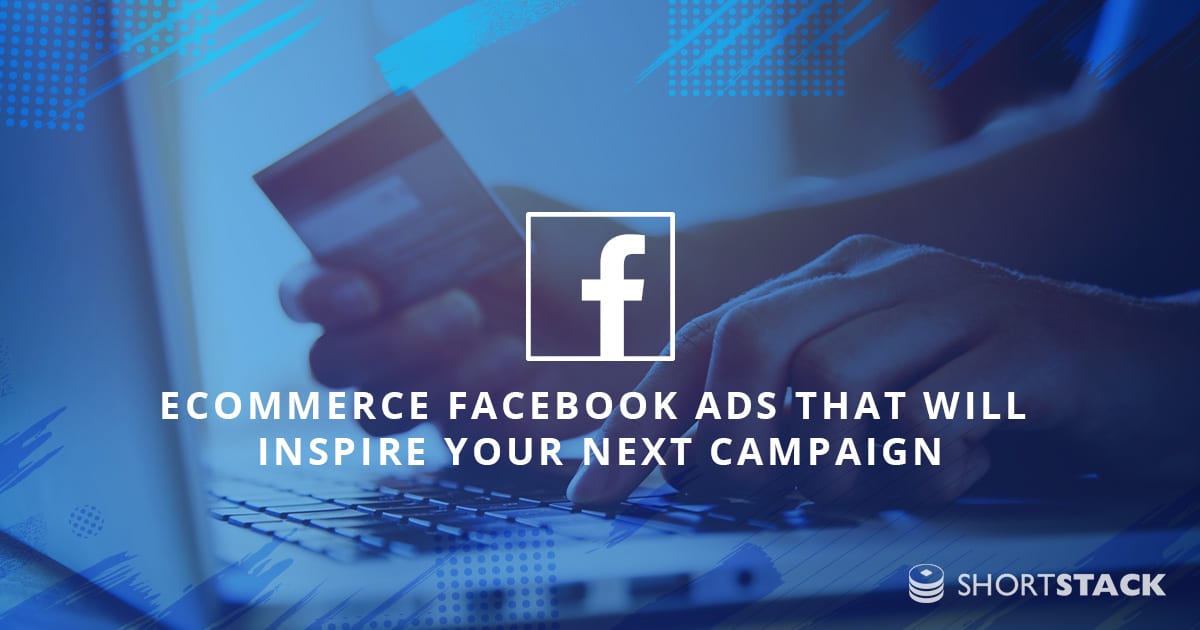
This content provides examples and tactics for creating effective eCommerce Facebook ads to stand out in the competitive landscape.
The eCommerce landscape is more competitive than ever.Every year, new ways to sell products online become available. From dropshipping, to Etsy, and the Facebook marketplace, starting an online business doesn’t require the capital outlay it once did. Anyone can start an online business and they can do so quickly without a huge budget.Given the increase in eCommerce businesses in almost all niches, business owners are actively seeking new ways to find customers and cut through the noise. While it’s not new, the Facebook ad platform provides an opportunity for eCommerce businesses to tap into new markets.The reason this advertising channel is so attractive to savvy eCommerce entrepreneurs is that it is constantly changing. If you have your finger on the pulse of what’s working in the world of Facebook ads, you can get a leg up on your competition.The best way of learning what works on Facebook is to run your own ads, test variations, and improve your campaigns over time. However, this can be expensive and time-consuming. As an alternative, you could look to monitor other eCommerce brands that are spending big on Facebook ads and draw inspiration from their tactics.In this article, I’ve collected a list of eCommerce Facebook ad examples that will give you a shortcut. Each ad is supported with a tactic for improving your campaigns.Let’s get started…
#1. Stunning images
The best eCommerce Facebook ads use high-quality, professionally shot images that stand out in the newsfeed. They are not ‘stock’ images that look fake and overly-orchestrated, but instead beautiful representations of your product in real-life situations.Watch company MVMT always use high-quality images of their products in their Facebook ads, and you can notice the difference:

eCommerce Facebook ad with stunning image.You will see that the product is always the focal point of their photos. They are also crystal clear, simple, and stylish.
#2. Faces in images
At the end of the day, you’re selling products to humans. Humans connect with other humans which is why using faces in images is a popular tactic for eCommerce businesses.There is something about the welcoming face of a person that catches our attention. It’s personal, emotive, and allows the individual to visualize themselves using your product.This tactic is particularly common in the fashion industry where brands like to show people what it would actually be like to wear their clothes. Here’s one example from Polo Ralph Lauren:

eCommerce Facebook ad using human faces.
#3. Simplicity with images
As I mentioned in the MVMT example above, as well as creating stunning and eye-catching images, simplicity is powerful. Overly complex images with lots of noise and distracting elements draw attention away from your product. Creating simple images which include a large proportion of empty space and draw focus to your product is key.Edible Blooms are one eCommerce store who keep things extremely simple with their Facebook ad images - and it works:
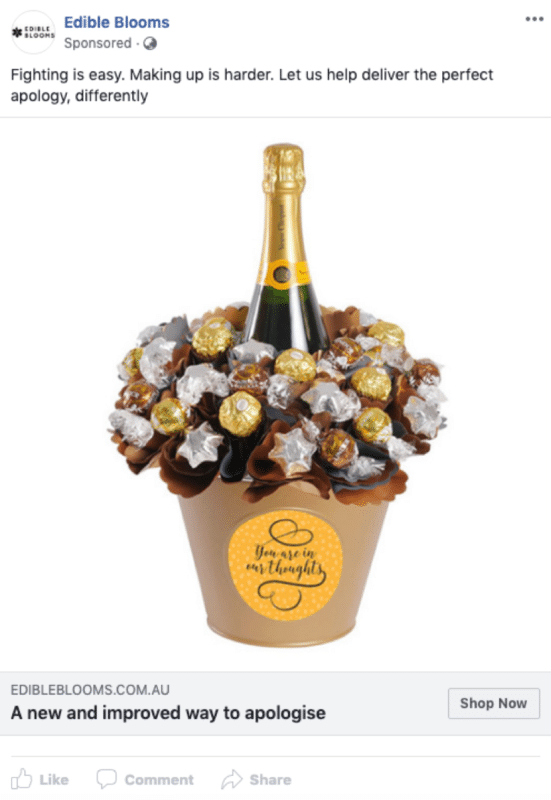
Example of simple eCommerce Facebook ad.
#4. Focused value proposition
If your ad creative is good enough to catch someone’s attention you only have a few seconds to entice a click with your ad copy. That’s why you need to be extremely clear about your value proposition and be able to articulate it in as few words as possible.The ad below from watch brand Daniel Wellington is simple, elegant, and depicts a clear value proposition with the words “Quality and Design”:

Example of a focused value proposition in an eCommerce Facebook ad.
#5. Brand congruence
The importance of brand consistency is highly underrated in the eCommerce space. If you are using multiple channels to engage prospects - banner ads, search ads, blog posts, landing pages, contests, and even offline marketing - it’s critical to create a congruent experience for your prospects at every touchpoint. Your brand colors, fonts, logo, messaging, and tone of voice all need to be identical. A consistent and repeated brand experience across all channels makes your brand memorable and trustworthy.Printing company Snapfish include their logo and slogan in all of their image ads as a way to maintain brand congruence:
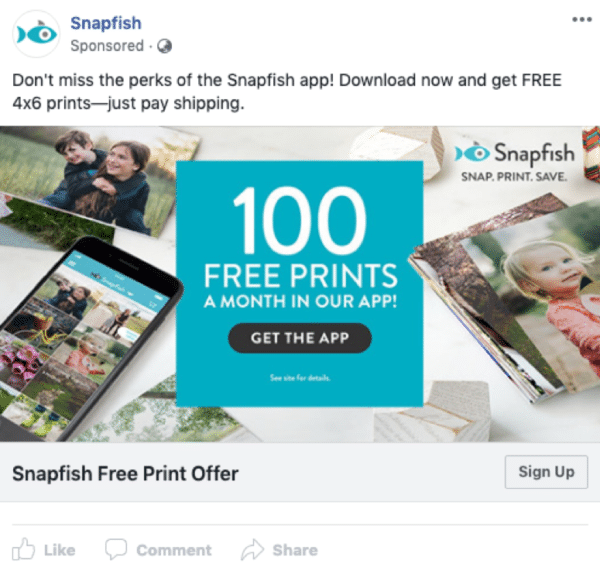
Example of brand congruence in an eCommerce Facebook ad.
#6. Call-to-action
eCommerce Facebook ads need to be designed to inspire action. Unlike Google Search ads, where visitors have a very strong and targeted intent when they are exposed to an ad, Facebook users aren’t actively seeking your product as they scroll through their newsfeed. As well as capturing their attention with stunning visuals and focused copy, your ads need a call-to-action.The goal of your ad is to get more people to visit your store. Your ad copy, design, offer, and button should all aim to achieve this goal.Mattress brand Koala leveraged the Easter period to create urgency and deliver a compelling call-to-action in the Facebook ad below:
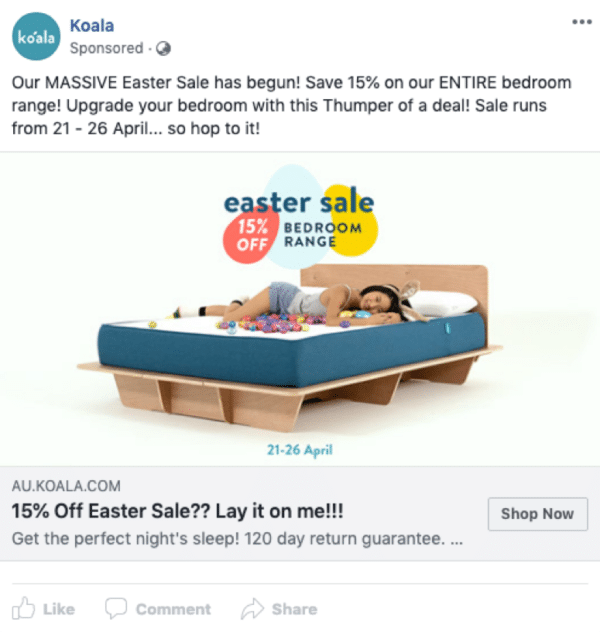
An eCommerce Facebook ad with a clear call-to-action.
#7. Multiple versions and split testing
The only way to improve your return on investment from Facebook ads, just like any marketing activity, is to test your tactics. Every eCommerce brand is going to be different and their customers will resonate with subtly different ads. The most successful brands on Facebook test a variety of ads by changing the creative, copy, offer, and targeting.In the ads below, stationary company, Smiggle, test a combination of carousel ads and videos to promote their 3 for 2 sale:

eCommerce Facebook ads using split testing.
#8. Social proof
Online consumers are regularly comparing brands, searching for deals, and assessing your products based on the opinions of other customers, friends, or family. This is especially true on a platform such as Facebook which is extremely community focused. One way you can establish trust and credibility with your Facebook ads is to incorporate social proof such as testimonials and customer stories.K9 Sport Sack, a carrier bag for dogs, regularly use customer stories and images to establish social proof for their product:
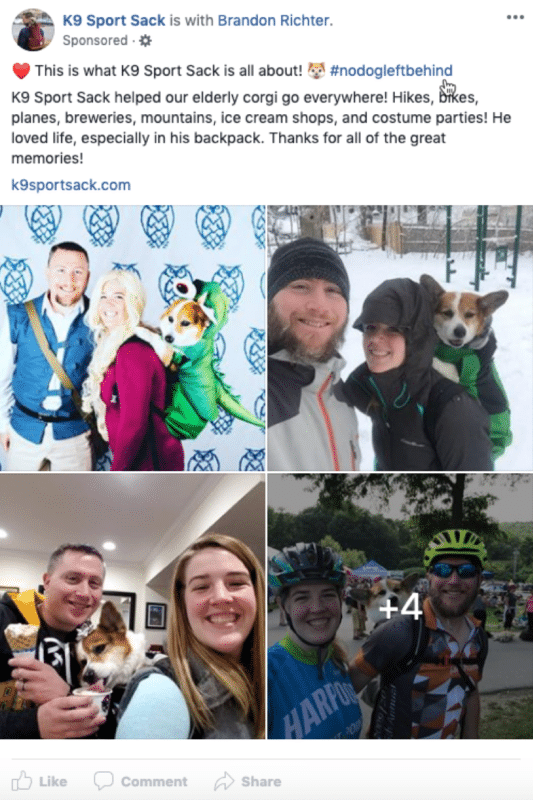
Example of social proof in an eCommerce Facebook ad.
#9. Engagement
Leading on from the point above about social proof, it’s in human nature to feel more comfortable when buying a product if your friends and family have purchased it before and recommend it. On a similar level, if your friends and family associate with a brand then it automatically makes you feel like that brand is trustworthy.One way of tapping into this feeling of trust by association is to deliberately generate engagement on your Facebook posts by running an ad campaign that is optimized for engagement, and then using the same post in a campaign optimized for sales.The below ad for a contest from French Bulldog brand Ask Frankie is a great example of how engagement, such as likes and comments, can significantly spread the reach of your campaign:

The importance of engagement in an eCommerce Facebook ad.
#10. Carousel ads
Carousel ads which allow users to scroll through a series of images are a popular choice in the eCommerce industry. You can use the allotted images to show off your diverse product range or create a photo-to-photo story board. This style of Facebook ad engages prospects who are curious about which image is going to come next and can grab their attention when scrolling the Newsfeed.Fashion brand Modcloth regularly use carousel ads to show off their product range:
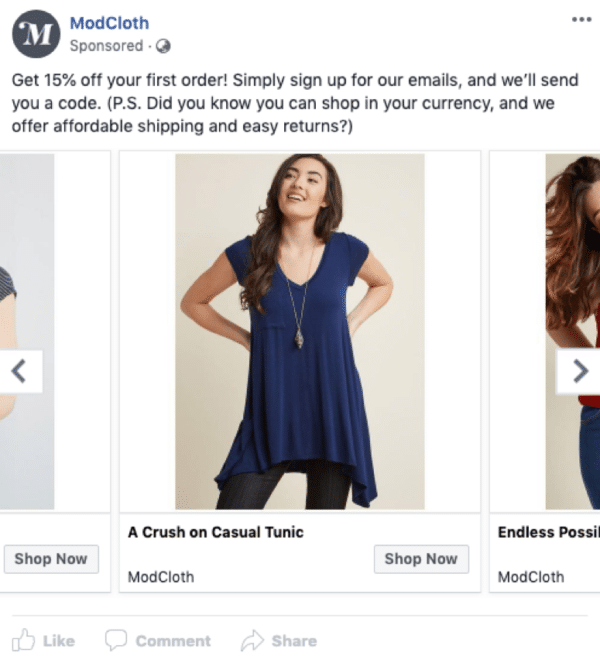
Example of carousel ads being used for a fashion brand.
#11. Humor, emotion or curiosity
Given the ‘social’ nature of Facebook, your ads need to connect with people on a personal level. Connection comes from unlocking emotion, curiosity, or a cheeky giggle from your prospects. If you can connect emotionally with people, your brand becomes memorable and the relationship is far more sustainable than a simple transaction.Chubbies are a great example of a brand using humor in their marketing, like the Facebook ad below:

Humor being used in an eCommerce Facebook ad.
#12. Product previews
Not surprisingly, the best eCommerce ads include a preview of the product you are selling. All of the examples we’ve looked at so far have shown off the product with smart photography, cheeky humor, or customer stories.This ad from Ben & Jerry’s perfectly hero’s their product with a tantalizing tub of ice cream surrounded by the ingredients it includes:

Example of a product preview in an eCommerce Facebook ad.
#13. Video ads
By running video ads on Facebook, you increase your exposure to areas of the social network that generate significant engagement. More and more Facebook are giving prominence to video in Stories, Watch, and the Video section of users’ profiles. It’s also easier than ever to create video ads with the technology available in the Facebook ads manager, to create moving graphics and slideshows with music.For example, BarkBox use moving image technology rather than traditional video in their ads:

eCommerce Facebook ad that uses video.
Conclusion
When creating your next Facebook ad campaign, remember to consider the behavior of users on this social network. They’re looking for connection with their friends, family, and those with shared passions. They want emotion, humor, and time-killing entertainment. If you can replicate these desires in your ads you will stand out from the crowd and unlock Facebook’s enormous potential.
Create a Facebook contest to generate leads and sales. Free.
Get Started Today. No credit card required. Risk-free.




